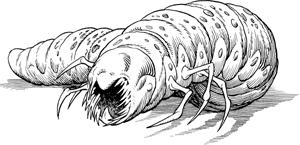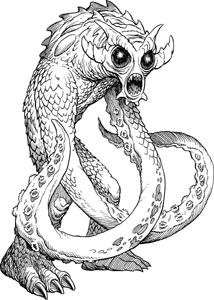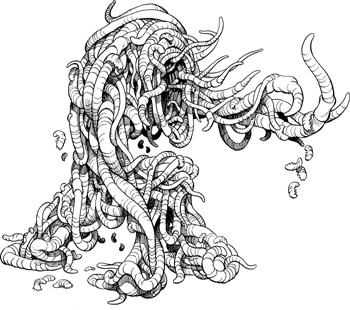The Shadowhunter's Codex (12 page)
Read The Shadowhunter's Codex Online
Authors: Cassandra Clare,Joshua Lewis
Tags: #Juvenile Fiction, #Horror & Ghost Stories, #Lifestyles, #City & Town Life, #Fantasy & Magic, #Social Issues, #New Experience, #Paranormal

DREVAK
Shadowhunters know well the appearance of Drevaks, weak demons in frequent use by Greater Demons or evil warlocks as spies or messengers. They are smooth, white, and larval, resembling a giant version of a mundane grub or maggot. They are blind and do their tracking by scent.
Their shapelessness and lack of intelligence does not mean they are not dangerous; instead of teeth their mouths contain poisonous spines, which can be very dangerous if they break off and stick in the skin of a victim. Normal treatments for demon venom apply here.

DU’SIEN
The Du’sien is one of the lesser-known shape-shifting, or Eidolon, demon species (see below). Its true appearance is abstract, like an irregular blob of greenish-gray jelly with a small glowing black core. They cannot mimic other creatures with the detail that many Eidolon can, and their command of human language is weak. They are thus often found disguised as “generic humans,” members of a crowd, rather than impersonating specific individuals.
EIDOLON
“Eidolon” is not the name for a specific species of demon. Rather, it is a comprehensive term for a variety of shape-shifting demon species. Shape-shifting demons come in many different original shapes, and many different sizes and strengths. Since there are dozens of these species, Shadowhunters typically use the term “Eidolon” to refer to shape-shifting demons in general. It is, in other words, usually more useful to note a demon’s shape-shifting ability than the minor details of their original form.
Eidolon demons make up the majority of demon parents of warlocks, for obvious reasons. (See the “Warlocks” section of Part II of this Bestiaire for an explanation if the reasons are not obvious to you.)
In addition to the danger posed by their nearly perfect ability to camouflage themselves, Eidolon also have a marked advantage over other demon species: When shifted into the form of a human, they are somewhat protected from the destructive light of the sun. A shifted Eidolon demon still cannot stand in direct sunlight but can endure the diffused light coming through heavy clouds, fog, rain, and so on, with only minor discomfort.
FACEMELTER
Self-explanatory.
HELLHOUND
A demonic corruption of the dog, just as many demons are corruptions of the forms of men and women. Typically hellhounds appear as vicious canines much larger than any mundane dog, with red eyes, coarse black wirelike fur, and a murderous temperament. They have a similar intelligence to mundane dogs and are used by demons for similar purposes—tracking and hunting. (Obviously there are many uses for mundane dogs, such as herding and companionship, that hellhounds are never used for, since demons are incapable of concepts such as companionship.) Like with dogs, hellhounds’ jaws are their most dangerous weapons, but unlike with dogs, their tails end in a set of spiked nail-like protrusions, similar to a mace.
HYDRA
A medium-size multiheaded demon, vicious but not intelligent. Known for its multiple heads, at least three but often many more. The Hydra can be distinguished from other multiheaded demons by its animalistic intelligence level, the presence of heads on stalks, and its blindness—the Hydra cannot see normally and relies on sound, scent, and its sheer number of large mouths to catch its prey.
IBLIS
The Iblis demon is corporeal but not of solid form. Instead it has the appearance of a figure about the size and shape of a human but made of a roiling, fast-moving black smoke. In the part of its vapor that represents its head, it looks out onto our world through yellow burning eyes.
IMP
The common Imp is a small humanoid with the characteristics of a typical Western devil—horns, forked tail, et cetera. They are not very dangerous individually but can become a problem when encountered in swarms of more than two hundred, as is occasionally reported.
DJINN
Djinn are mentioned here because they are often incorrectly believed to be demons. They are not; they are faeries.
KAPPA
A reptilian water demon covered in a protective carapace and with a protruding beak, but otherwise the size and rough shape of a human ten-year-old child. Fond of leaping from the water to drag unwitting mundanes to their deaths.
KURI
These are spider demons, large and shiny black, with eight pincer-tipped arms, and fangs extending from their eye sockets.
MOLOCH
Somewhat confusingly, the name “Moloch” refers both to a Greater Demon known as one of the most fearsome demon warriors, a being of smoke and oil, and also to a species of lesser demons (“Molochs”) that are minions and foot soldiers of the Greater Demon Moloch. Individuals of the species are man-size, dark, and made of thick roiling oil, with arms but only a formless liquid appendage instead of legs. Their primary weapon is the flames that stream from their empty eye sockets, and they are usually seen in large numbers rather than in isolation.
ONI
Human-size demons with green skin, wide mouths, and horns upon their heads.
RAHAB
These are large bipedal demons, somewhat lizardlike in appearance and movement. They are blind, with a line of teeth where their eyes should be, and a regular mouth, this one fanged and tusked, in a more usual place on their faces. They have a narrow, whiplike tail edged with razor-sharp bone. Their talons and teeth are, of course, sharp and dangerous, but their most threatening weapon is the bulb-shaped stinger on the end of their long, forked tongue.

RAUM
The Raum is an intimidating and dangerous demon, not capable of speech, but somewhat clever as an opponent nonetheless. Raums are about the size of a man but possess white, scaled skin, bulging black eyes without pupils, a perfectly circular mouth, and tentacles for arms. These tentacles are the Raum’s most dangerous weapon; they are tipped with red suckers, each of which contains a circle of tiny needlelike teeth.
RAVENER
The Ravener is a classic monstrosity: a long, squamous black body with a long domed skull like an alligator’s. Unlike on an alligator, its eyes are in an insectile cluster on the top of its head. It has a vicious, barbed whip tail and a thick, flat snout. Raveners possess sharp fanged teeth, which envenomate their prey with a deadly toxin. In time the poison will burn away all of the life of the victim, leaving only ash behind. The toxin is particularly terrible even among demon venoms, and there we are talking about a category that includes the poison of the Facemelter demon. (See “
Facemelter
,”.)
SHAX
These demons are known for their keen sense of smell and are sometimes summoned by warlocks to use in tracking a missing person. They must be carefully controlled, however; they are brood parasites and reproduce by wounding a victim and then laying their eggs in the still-living victim’s skin.

VERMITHRALL
Most Shadowhunters will incorrectly tell you that the Vermithrall is a monstrous lumbering mass made up of thousands of writhing worms. In fact the Vermithrall are the individual worms themselves. They do, however, collect into colonies in the shape of a humanoid and attack as a unified single entity. Worse, worms separated from the main body will endeavor to rejoin it, making it very hard to permanently kill a Vermithrall.
VETIS
They are not to be confused with Dragon demons, which they somewhat resemble but are unrelated to. They are gray and scaly, with overlong serpentine arms and an elongated but humanoid body. Like Dragons, they are known for hoarding valuables; unlike Dragons, they do not have any understanding of what is valuable and what is dross, and their lairs are more closely reminiscent of large rats’ nests than treasure chambers.
MUNDANE DEMONIC CULTS
Through history there have been any number of pathetic, misguided groups of mundanes who have built small cults around the worship of a particular demon or group of demons. Most of these cults are of little interest to Nephilim and serve only to clutter and confuse demonic histories, since they are based around demons that are merely imagined or invented.
Nevertheless, a minority of these demon cults have successfully raised weak minor demons. These stories usually end with the cult improperly binding the demon and the demon immediately killing all of the cult’s members. In a small number of cases, a successful demon cult has endured for a short time, with the demon served by the cult members and asking little in return. These cults inevitably fade after a generation or two and are of little concern to us historically, but they may cause local trouble and require Shadowhunter intervention.
Mundane members of demon cults are often barely human by the time that intervention is needed. Their worshipped demon is likely to have consumed their humanity for fuel, to maintain and strengthen itself. This leaves behind mere shells of humans, their physical bodies in active decay and their souls worn down to a constant animalistic rage. This state is considered irreversible; killing these demon-degraded mundanes is considered an act of mercy and is thus within the bounds of the Law.
Cults have existed to serve Greater Demons, but there is little evidence that any of these have ever successfully summoned the subject of their worship. If they have, the likelihood is that they were immediately annihilated and no record exists of them to teach us of their folly.
THE DEMON POX
Astriola, or demon pox, is a rare but debilitating illness that affects Shadowhunters and is caused by inappropriate contact with demons. The illness is not often seen, because this kind of inappropriate contact is, luckily, not common. Mundanes are immune to the disease; it is assumed to be caused by the interaction of demon poisons with the angelic nature of Shadowhunters.
The first signs of demon pox are a shield-shaped rash on the back of the sufferer, which then spreads over the body, creating fissures in the skin. From this point the afflicted Shadowhunter will deteriorate physically, experiencing fever, chills, nausea, oozing sores, non-oozing sores, buboes, a film of black over the eyes, hair ejection, and other similar signs of distress. In time the sores and fissures cover the skin of the victim entirely, and they form a dark chrysalis within which the victim transforms, painfully and over the course of several weeks, into a demon himself. Once the demon emerges from the chrysalis, the previously existing person is in effect deceased, and the only end to the torment is to kill the demon.
Other books
The Time-Traveling Fashionista by Bianca Turetsky
Death in an Ivory Tower (Dotsy Lamb Travel Mysteries) by Maria Hudgins
ATasteofLondon by Lucy Felthouse
Cutting Up The Competition (Horror High #2) by Carissa Ann Lynch
Kingdom by Tom Martin
Inside Enemy by Alan Judd
Mortal Fear by Mortal Fear
Star League 2 by H.J. Harper
Enduring Retribution e-book by Kathi S. Barton
I Love Female Orgasm: An Extraordinary Orgasm Guide by Dorian Solot, Marshall Miller
